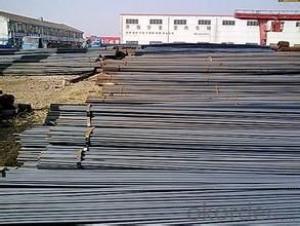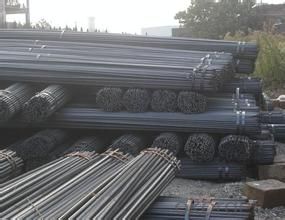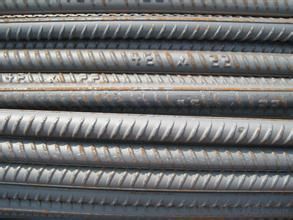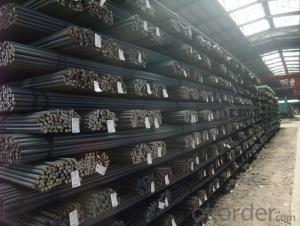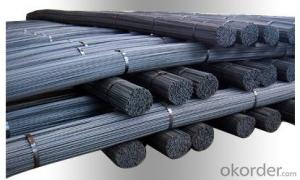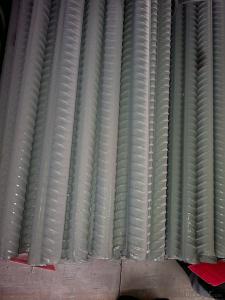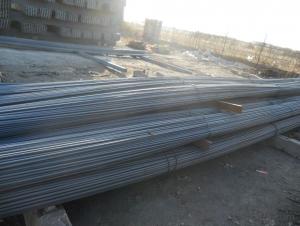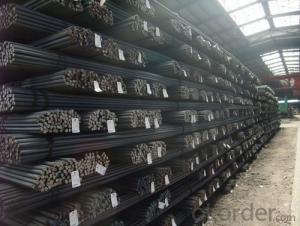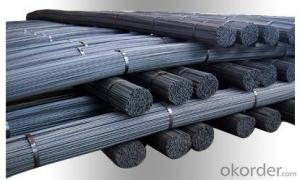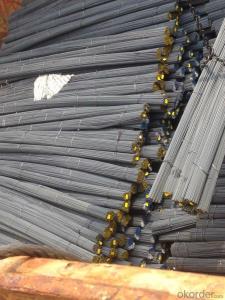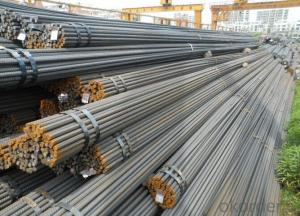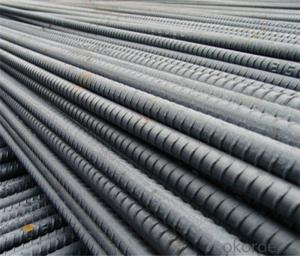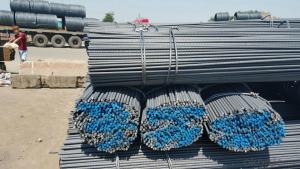GB1449 deformed steel bar for construction
- Loading Port:
- Tianjin
- Payment Terms:
- TT OR LC
- Min Order Qty:
- 25 m.t.
- Supply Capability:
- 10000 m.t./month
OKorder Service Pledge
OKorder Financial Service
You Might Also Like
Product Description:
Specifications of Deformed Steel Bar:
Standard | GB | HRB335, HRB400, HRB500 | |
UK | G460B, B500A, B500B,B500C | ||
USA | GR40, GR60 | ||
Diameter | 6mm,8mm,10mm,12mm,14mm,16mm,18mm,20mm, 22mm,25mm,28mm,32mm,36mm,40mm,50mm | ||
Length | 6M, 9M,12M or as required | ||
Place of origin | Hebei, China mainland | ||
Application | building,construction,road,bridge etc | ||
Brand name | DRAGON | ||
Theoretical weight and section area of each diameter as below for your information:
Diameter(mm) | Section area (mm²) | Mass(kg/m) |
6 | 28.27 | 0.222 |
8 | 50.27 | 0.395 |
10 | 78.54 | 0.617 |
12 | 113.1 | 0.888 |
14 | 153.9 | 1.21 |
16 | 201.1 | 1.58 |
18 | 254.5 | 2.00 |
20 | 314.2 | 2.47 |
22 | 380.1 | 2.98 |
25 | 490.9 | 3.85 |
28 | 615.8 | 4.83 |
32 | 804.2 | 6.31 |
36 | 1018 | 7.99 |
40 | 1257 | 9.87 |
50 | 1964 | 15.42 |
Usage and Applications of Deformed Steel Bar:
Deformed bar is widely used in buildings, bridges, roads and other engineering construction. Big to highways, railways, bridges, culverts, tunnels, public facilities such as flood control, dam, small to housing construction, beam, column, wall and the foundation of the plate, deformed bar is an integral structure material. With the development of world economy and the vigorous development of infrastructure construction, real estate, the demand for deformed bar will be larger and larger..
Packaging & Delivery of Deformed Steel Bar:
Packaging Detail: products are packed in bundle and then shipped by container or bulk vessel, deformed bar is usually naked strapping delivery, when storing, please pay attention to moisture proof. The performance of rust will produce adverse effect.
Each bundle weight: 2-3MT, or as required
Payment term: TT or L/C
Delivery Detail: within 45 days after received advanced payment or LC.
Label: to be specified by customer, generally, each bundle has 1-2 labels
Trade terms: FOB, CFR, CIF
Deformed Steel Bar in Coil
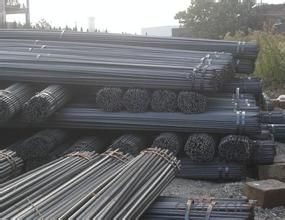
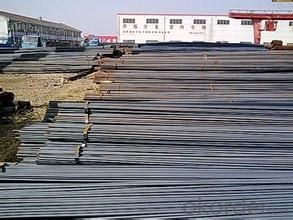
Produce Line of Deformed Steel Bar
Note:
1. Our products are produced according to national standard (GB), if not, supply according to national standards (GB) or agreement as customer required.
2. Other Grade and Standard Deformed Steel Bar we can supply:
Grade: GR40/GR60, G460B/B500A/B500B/B500C,BST500S
Standard: ASTM, BS, DIN
The Minimum Order Quantity of these products is high, and need to be confirmed.
3. We can not only supply Deformed Steel Bar; if you need anything about building materials, please contact us for further information.
4. Please send us your detail specifications when inquire. We will reply to you as soon as possible. We sincerely hope we can establish a long stable business relationship.
- Q: How are steel rebars handled and stored on construction sites?
- Construction projects that require reinforced concrete structures rely on steel rebars, which are also known as reinforcing bars. Ensuring the quality and safety of these rebars when handling and storing them on construction sites is of utmost importance. Upon delivery to the construction site, the steel rebars must undergo inspection for any signs of damage or corrosion. If any rebars are found to be damaged, they should be discarded as they can compromise the project's structural integrity. Additionally, the rebars should be checked for proper labeling, including grade, size, and other specifications. Mechanical lifting equipment, such as cranes or forklifts, is typically used to handle steel rebars. It is crucial to use appropriate lifting tools to prevent mishandling or accidents that could result in injuries. The rebars should be lifted vertically to avoid bending or distortion. Once lifted, the steel rebars should be stored in a designated area called a rebar yard. This yard should be clean, well-drained, and organized to prevent potential damage or corrosion. The rebars should be stacked horizontally on leveled ground, ensuring they do not come into direct contact with the soil or water to avoid rusting. To prevent the rebars from rolling or falling, they should be securely tied together using binding wires or steel bands. This practice not only helps maintain the order and stability of the stored rebars but also prevents accidental damage by keeping them away from other construction materials, machinery, or equipment. Proper storage also involves protecting the rebars from adverse weather conditions. Waterproof tarpaulins or plastic sheets should be used to cover the rebars, preventing moisture absorption and corrosion. Adequate ventilation is necessary to avoid moisture accumulation, which can lead to rusting. Regular inspections of the stored rebars are crucial to identify any signs of damage or deterioration. If any rebars are found to be damaged or rusty, they should be promptly removed and replaced to preserve the structural integrity of the construction project. In conclusion, the handling and storage of steel rebars on construction sites require careful attention. Suitable lifting equipment should be used during handling, and a clean and organized rebar yard is necessary for storage. Regular inspections and maintenance are essential to ensure the rebars' quality and prevent any compromise to the construction project's structural integrity.
- Q: How do steel rebars impact the overall aesthetics of concrete structures?
- Steel rebars have a significant impact on the overall aesthetics of concrete structures. While concrete is known for its strength and durability, it lacks the tensile strength to resist bending or stretching forces. This is where steel rebars come into play. By reinforcing concrete with steel rebars, the structural integrity of the concrete is greatly enhanced. This allows engineers and architects to design more complex and ambitious structures, such as high-rise buildings, bridges, and stadiums. The use of steel rebars provides the necessary strength and flexibility to withstand heavy loads, seismic activity, and other environmental forces. However, the presence of steel rebars can affect the appearance of the concrete structure. In some cases, particularly in exposed concrete finishes, the visibility of steel rebars can be seen as a visual distraction or an undesirable element. The exposed steel rebars may create a grid-like pattern or a rusty appearance, which can be perceived as unattractive or out of harmony with the surrounding environment. To mitigate this aesthetic impact, various techniques are employed. One common approach is to use concrete coverings or coatings to hide the steel rebars and create a smooth and uniform surface. These coverings not only serve the purpose of improving the appearance but also provide protection against corrosion and extend the lifespan of the structure. Another method is to employ decorative techniques such as formwork or molds to create unique patterns or textures on the concrete surface. This way, the steel rebars are concealed within the design, adding to the overall aesthetic appeal of the structure. By incorporating architectural features, such as curves or geometric shapes, the presence of steel rebars can be turned into a visual asset rather than a hindrance. It is worth noting that in certain architectural styles, such as Brutalism, the raw and exposed nature of concrete structures, including the visibility of steel rebars, is celebrated as an artistic expression. In these cases, the industrial and utilitarian aesthetic is embraced, and the steel rebars become an integral part of the overall design concept. In conclusion, steel rebars have a significant impact on the aesthetics of concrete structures. While their presence can sometimes be seen as an obstacle to achieving a desired visual outcome, various techniques and design approaches can be employed to either conceal or incorporate steel rebars into the overall architectural design, resulting in aesthetically pleasing and structurally sound concrete structures.
- Q: How do steel rebars contribute to the overall seismic performance of a structure?
- Steel rebars contribute to the overall seismic performance of a structure by enhancing its strength, ductility, and energy dissipation capacity. These reinforcement bars are embedded in concrete and help to resist the forces generated during an earthquake. By providing tensile strength to the concrete, rebars prevent cracks and brittle failure, enabling the structure to withstand the seismic forces and safely dissipate the energy. Overall, steel rebars significantly improve the resilience and structural integrity of buildings during seismic events.
- Q: How do steel rebars improve the ductility of a structure?
- Steel rebars improve the ductility of a structure by providing reinforcement and resistance to tension forces. When a structure is subjected to external loads, such as earthquakes or high winds, it experiences tensile stresses which can lead to cracking and failure. However, steel rebars, which are typically made of high-strength steel, are added to concrete structures to enhance their ability to withstand and distribute these forces. The presence of rebars in the concrete increases its tensile strength, allowing it to resist deformation and cracking. When the structure is subjected to tension, the rebars bear the majority of the load, preventing the concrete from failing. This redistribution of forces results in increased ductility, which is the ability of a material to undergo deformation without breaking. Furthermore, steel rebars also enhance the structural integrity of a building by preventing the propagation of cracks. As the concrete cracks under tension, the rebars act as a barrier, limiting the growth of these cracks and preventing them from spreading throughout the structure. This containment of cracks improves the overall resilience of the building, minimizing the risk of catastrophic failure. Overall, steel rebars play a crucial role in improving the ductility of a structure by enhancing the tensile strength, redistributing forces, and limiting crack propagation. By incorporating rebars into concrete, engineers can design and construct structures that are capable of withstanding a wide range of external forces, thereby ensuring the safety and durability of the building.
- Q: How do steel rebars contribute to the fire resistance of concrete?
- Steel rebars contribute to the fire resistance of concrete in several ways. Firstly, steel has a high melting point and is a non-combustible material, which means it does not burn or add fuel to a fire. This property of steel rebars helps prevent the spread of fire and provides structural stability to the concrete during a fire event. Additionally, steel rebars act as a reinforcement within the concrete, enhancing its overall strength and load-bearing capacity. This reinforcement helps to prevent the concrete from cracking or breaking apart under high temperatures caused by a fire. The presence of steel rebars also improves the ductility of the concrete, allowing it to deform and absorb energy during a fire, rather than shattering or collapsing suddenly. Moreover, the thermal conductivity of steel is higher than that of concrete, meaning it can conduct heat away from the fire zone more effectively. This helps to dissipate heat and prevent it from reaching critical levels that could compromise the structural integrity of the concrete. By absorbing and distributing heat, steel rebars help to slow down the rate of temperature rise within the concrete during a fire. In summary, steel rebars contribute to the fire resistance of concrete by providing structural stability, enhancing strength and load-bearing capacity, improving ductility, and dissipating heat. These properties make concrete structures reinforced with steel rebars more resilient and capable of withstanding fire events for a longer duration, thereby increasing the safety of occupants and reducing potential property damage.
- Q: How do steel rebars prevent cracks in concrete structures?
- Steel rebars prevent cracks in concrete structures by providing tensile strength to the concrete. When the concrete dries and hardens, it becomes strong in compression but weak in tension. The presence of steel rebars within the concrete adds tensile strength, allowing the structure to resist cracking under tensile stresses. The rebars act as reinforcement, absorbing and distributing the tensile forces throughout the concrete, preventing the formation and propagation of cracks.
- Q: What are the different types of steel rebars available in the market?
- There are several types of steel rebars available in the market, including mild steel rebar, high-strength deformed steel rebar, epoxy-coated steel rebar, stainless steel rebar, and galvanized steel rebar. Each type has its own unique properties and uses, making them suitable for various construction applications.
- Q: Can steel rebars be used in bridges and highways?
- Yes, steel rebars can be used in bridges and highways. Steel rebars are commonly used as reinforcement in concrete structures, including bridges and highways, to enhance their strength and durability. The rebars are embedded within the concrete to provide additional tensile strength, which is crucial for withstanding the various loads and stresses that bridges and highways are subjected to. Steel rebars are preferred due to their high strength-to-weight ratio, corrosion resistance, and ability to bond well with concrete. Additionally, they can be easily fabricated and shaped to suit the design requirements of the bridge or highway. Overall, steel rebars are a vital component in the construction of bridges and highways, ensuring their structural integrity and longevity.
- Q: Can steel rebars be galvanized for added protection?
- Yes, steel rebars can be galvanized for added protection. Galvanizing involves coating the rebars with a layer of zinc, which provides a protective barrier against corrosion and extends their lifespan.
- Q: How are steel rebars protected from theft during construction?
- Steel rebars are protected from theft during construction through various measures such as storing them in secure areas, implementing strict access control, utilizing surveillance systems, and employing security personnel. Additionally, some construction sites may also use special marking or tracking systems on the rebars to deter theft and aid in their recovery if stolen.
Send your message to us
GB1449 deformed steel bar for construction
- Loading Port:
- Tianjin
- Payment Terms:
- TT OR LC
- Min Order Qty:
- 25 m.t.
- Supply Capability:
- 10000 m.t./month
OKorder Service Pledge
OKorder Financial Service
Similar products
Hot products
Hot Searches
Related keywords
